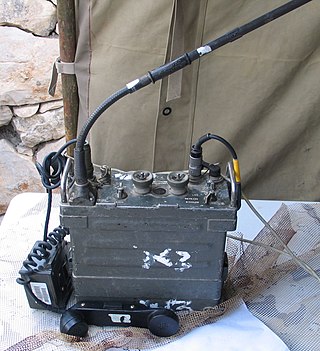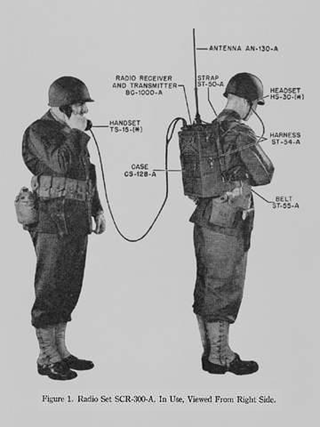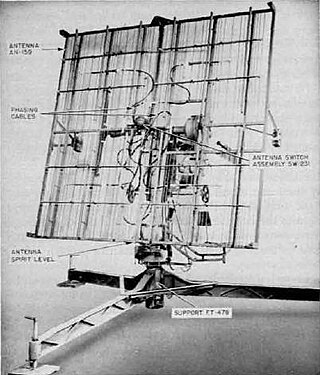The SCR-694 was a portable two way radio set used by the U.S. military during World War II.
Contents

The SCR-694 was a portable two way radio set used by the U.S. military during World War II.

The SCR-694 began to replace the SCR-284 from mid 1944 [1] , with improved range and reduced weight (around half of its predecessor), though the latter continued to be used up until the end of the war. Designed to provide communication between moving or stationary vehicles or as a portable field radio set, the SCR-694 was originally intended for use by mountain troops and airborne forces but soon became the Army-wide standard at battalion level.
The SCR-694 saw use all over the army in many different theaters; notable instances include at regimental division headquarters during the Normandy invasion [2] and the Cabanatuan prison raid [3] as well as by scouts and reconnaissance units in the Pacific War. [4]
It was later replaced by the AN/GRC-9, which saw first documented use in the Korean war.
The SCR-694 "Radio set, Portable/Vehicular" consisted of the BC-1306 vacuum tube transmitter/receiver capable of AM and CW mode operation between 3.800 and 6.500 MHz.
{{cite web}}: Missing or empty |title= (help)
AN/PRC 77 Radio Set is a manpack, portable VHF FM combat-net radio transceiver manufactured by Associated Industries and used to provide short-range, two-way radiotelephone voice communication. In the Joint Electronics Type Designation System (JETDS), AN/PRC translates to "Army/Navy, Portable, Radio, Communication."

A walkie-talkie, more formally known as a handheld transceiver (HT), is a hand-held, portable, two-way radio transceiver. Its development during the Second World War has been variously credited to Donald Hings, radio engineer Alfred J. Gross, Henryk Magnuski and engineering teams at Motorola. First used for infantry, similar designs were created for field artillery and tank units, and after the war, walkie-talkies spread to public safety and eventually commercial and jobsite work.

The SCR-270 was one of the first operational early-warning radars. It was the U.S. Army's primary long-distance radar throughout World War II and was deployed around the world. It is also known as the Pearl Harbor Radar, since it was an SCR-270 set that detected the incoming raid about 45 minutes before the December 7, 1941, attack on Pearl Harbor commenced.

The AN/ARC-5 Command Radio Set is a series of radio receivers, transmitters, and accessories carried aboard U.S. Navy aircraft during World War II and for some years afterward. It is described as "a complete multi-channel radio transmitting and receiving set providing communication and navigation facilities for aircraft. The LF-MF-HF components are designed to transmit and receive voice, tone-modulated, and continuous wave (cw) signals." Its flexible design provided AM radiotelephone voice communication and Modulated continuous wave (MCW) and Continuous wave (CW) Morse code modes, all of which are typical capabilities in other Navy aircraft communication sets of the period. It was an improvement of the Navy's ARA/ATA command set. Similar units designated SCR-274-N were used in U.S. Army aircraft. The Army set is based on the ARA/ATA, not the later AN/ARC-5. The ARA/ATA and SCR-274-N series are informally referred to as "ARC-5", despite small differences that render all three series incompatible. Like the AN/ARC-5, the ARA/ATA and SCR-274-N had AM voice communication and two-way MCW and CW Morse code capability.

The SCR-284 was a World War II era combination transmitter and receiver used in vehicles or fixed ground stations.

The SCR-536 was a hand-held radio transceiver used by the US Army Signal Corps in World War II. It is popularly referred to as a walkie talkie, although it was originally designated a "handie talkie".

Signal Corps Radios were U.S. Army military communications components that comprised "sets". Under the Army Nomenclature System, the abbreviation SCR initially designated "Set, Complete Radio", but was later misinterpreted as "Signal Corps Radio."

The SCR-299 was a U.S. Signal Corps mobile military communications unit used during World War II.

The SCR-658 radar is a radio direction finding set introduced by the U. S. Army in 1944, was developed in conjunction with the SCR-268 radar. It was preceded by the SCR-258. Its primary purpose was to track weather balloons. Prior to this it was only possible to track weather balloons with a theodolite, causing difficulty with visual tracking in poor weather conditions. The set is small enough to be portable and carried in a Ben Hur trailer.

The BC-610 was a radio transmitter based on the Hallicrafters HT-4 and was used by the U.S. Army Signal Corps during World War II.

The SCR-300 was a portable radio transceiver used by US Signal Corps in World War II. This backpack-mounted unit was the first radio to be nicknamed a "walkie talkie".

The SCR-277 was a mobile, trailer mounted radio range set for radio guidance of aircraft. It was standardized by the U.S. Army in June 1941.

The BC-342 was a World War II U.S. Army Signal Corps high frequency radio receiver. It was used primarily as part of field installations such as the SCR-188A, but could be used with mobile sets such as the 2 1/2 ton mounted SCR-399. First designed at Fort Monmouth, New Jersey by the U.S. Army Signal Corps, it was built by various manufacturers including RCA. Many of the later units that are encountered today were manufactured by the Farnsworth Television and Radio Corporation of Fort Wayne, Indiana. Variants include the low frequency coverage BC-344 receiver, and the battery or dynamotor powered BC-312 receiver.
The AN/MRN-1 was an instrument approach localizer used by the Army Air Force during and after World War II. It was standardized on 3 July 1942. It replaced the SCR-241, and was a component of SCS-51.
The AN/MRN-3 was a marker beacon set used by the Army Air Force during and after World War II, it was standardized 23 October 1943, and replaced SCR-241.

The SCR-245 Radio was a mobile MF/HF Signal Corps Radio used by the U.S. Army before and during World War II, for short range ground communications, It was one of the first crystal controlled sets used by the Army.

The SCR-508 radio was a mobile Signal Corps Radio used by the U.S. Army during World War II, for short range ground communications. The SCR-508 series radio represented the Army's commitment to both FM and crystal tuning, and was used extensively by armor and mechanized units. The turret bustle of late series light and medium tanks was designed around this radio.
During World War II, the German Army relied on an diverse array of communications to maintain contact with its mobile forces and in particular with its armoured forces. Most of this equipment received the generic prefix FuG for Funkgerät, meaning "radio device". Occasionally the shorted Fu designation were used and there were exceptions to both these systems. Number ranges were not unique across the services so sometimes different equipment used by different services had the same FuG prefix. This article is a list and a description of the radio equipment.